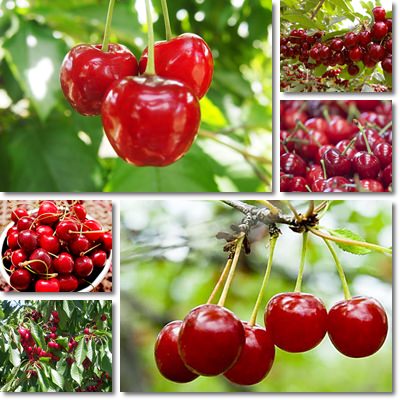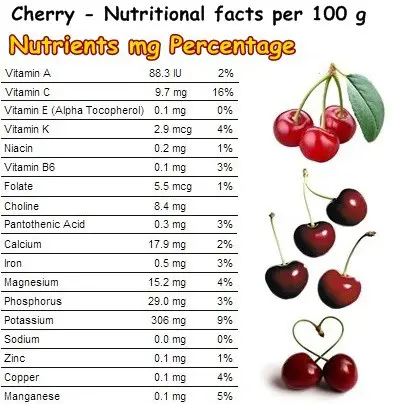Cherries (Prunus avium) are the beloved fruit of our childhood and most of us will never forget how their sweet, juicy, fragrant flesh put smiles on our faces every summer. But what we didn’t know was that these small, round, bright red drupes were one of the healthiest foods in the world. Not only do they promote longevity, but they also have impressive anticancer properties. Cherries are a powerful combination of antioxidants, vitamins, minerals and other nutrients with several wonderful health benefits.
Up next we will see just how healthy and nutritious they really are.
The sweet cherries we all know and love are a variety of wild cherries known as Prunus avium which date back to ancient Rome. Cherry trees were highly appreciated for their health benefits as well as for their beauty even in prehistoric times.
If you have ever seen an orchard of gorgeous, pink-white cherry blossoms, then you have seen heaven. Both the fruits and the blossoms are of economic importance, providing nourishment as well as breathtaking scenery.

What do cherries look like?
Cherries are botanical drupes or stone fruit, meaning each fruit has one large seed called a pit or a stone containing the seed. Fruits occur in an umbrella pattern and are attached to branches by pedicels of varying lengths so that all the fruits in a cluster are at roughly at the same level.
The sweet cherry, the most common cultivar, is typically 1-2 cm in diameter, but other varieties may be significantly larger. All cherries are more or less heart-shaped and have a smooth, bright-colored, edible skin.
The bulk of cherry fruit in cultivation are bright red, but there are also cultivars which are dark red or mahogany while others are a dark purple, almost black color.
Very dark colored cherries, whether dark red or very dark purple, are classified as black cherries. See the benefits of black cherries.
Yellow and white cherries are also becoming increasingly popular. Yellow cherries are either entirely yellow, skin and flesh, or have a yellow skin that is blushed with red, pink-red or orange and red such as Rainier cherries.
See the benefits of yellow cherries.
Despite their name, white cherries are not actually white, but rather a uniform pale to medium yellow color. The name is not meant as a literal description of the variety, which is also the case with white bell peppers which are not white at all, but rather a very pale green color. The name is used in the sense of yellow cherries as discolored cherries, or cherries that are not red.
Find out more about what are white cherries.

What do cherries taste like?
Cherries have a firm, meaty, but juicy flesh and thin skin. The common cherry is generally quite sweet, with light fruity flavors and a pleasant perfume to it. Yellow varieties tend to be even sweeter, while darker colored cherries have a richer flavor, intensely fruity, sweet and aromatic and a slight tartness around the skin. They are great fresh and cooked, but will provide the most benefits if eaten raw, preferably soon after being harvested.
Cherry blossom nectar, and also pollen, are used to make the popular cherry blossom honey, a honey variety with a range of therapeutic properties.
Discover the benefits of cherry blossom honey.
When is cherry season?
Cherries are in season at different times in the two hemispheres. In the Northern hemisphere, cherry season is June through August, depending on the region. In the Southern hemisphere, cherry season is November through January, peaking in December.
What are the benefits Of Cherries?
Why are cherries good for you? First of all, they help lower risks of cancer. Cherries contain Queritrin, a flavonoid and natural plant pigment with incredible anticancer properties. Regular consumption can supply the body with important amounts of Queritrin to activate apoptosis-inducing and anti-proliferative activities. Queritrin is believed to be one of the most potent anticancer agents in nature.
In addition to this cherries contain ellagic acid, a natural plant phenol with valuable carcino-preventive properties. Ellagic acid can efficiently prevent the proliferation of certain carcinogens and thus inhibit the development of cancer. Both Queritrin and ellagic acid have extraordinary antioxidant properties and further scavenge free radicals and counteract, limit and repair cell damage, with anticancer effects.
Cherries, and berries in general, are incredible sources of antioxidants. Eating them regularly helps repair cell damage caused by damaging free radical molecules. According to the ‘free radical theory of aging’, in time, the damage caused by free radicals builds up and causes premature aging, as well as diseases related to old age: cancer, arthritis, Alzheimer’s and so on.
Anthocyanins, the antioxidants found in red and black cherries, as well as blueberries, blackberries, red, purple and black raspberries, help prevent cell damage caused by oxidation and reduce risks of associated chronic conditions. This means that eating cherries can help us look young, feel better and add years to our life.
Even more, perillyl alcohol, a compound derived from cherry essential oil, has been shown to reduce cancerous tumors in animals by inducing apoptosis, programmed cell death, in cancer cells. Although oncologists have not yet had success with human trials, it is believed that eating cherries may naturally offer protection against cancer. Sour cherries, also known as tart cherries, are reported to have similarly potent anticancer properties.
Cherries list even more incredible benefits for health. For instance, they are a wonderful natural remedy against rheumatoid arthritis and gout, two painful inflammatory medical conditions. Select compounds occurring naturally in the fruit exert anti-inflammatory and analgesic properties and help relieve pain. Not just this, but anti-inflammatory foods such as cherries help slow down the progression of arthritis, resulting in reduced swelling and pain and improved mobility. Find out more about the benefits of cherries and cherry juice for arthritis pain.
COX or Cyclooxygenase is an enzyme found in several flavonoids, including those responsible for the beautiful, bright, red color of cherries. COX relieves pain by eliminating its cause: inflammation. This enzyme acts similarly to ibuprofen and aspirin, but without the side effects. This means cherries are a potent, natural anti-inflammatory and regular consumption helps manage both arthritis and gout.

In addition to all of these wonderful health benefits, cherries also supply our body with small quantities of almost all important vitamins and minerals. Vitamin C, potassium and manganese are the best represented micronutrients in the fruit. Both vitamin C and manganese have antioxidant and anti-inflammatory benefits, scavenging free radicals and limiting cell damage.
Vitamin C is also one of the reasons why cherries help with arthritis pain, joint swelling and gout flareups. Vitamin C has scientifically proven anti-inflammatory benefits, actively lowering levels of inflammation markers in the body such as C-reactive protein and Interleukin 6. See the benefits of cherries and cherry juice for gout.
Eating raw cherries every day or drinking fresh cherry juice supplies important amounts of potassium and contributes to blood pressure control and cardiovascular health. The content of potassium in cherries and cherry juice, as well as compounds such as melatonin recommend the fruit for sleep problems. See the benefits of cherries and cherry juice for sleep.
Moreover the fruit contains about 2 grams of dietary fiber for every 100 grams, making it a great natural remedy for constipation. Not just this, but cherries have a good content of pectin which is a type of dietary fiber with a gelling effect. Pectin turns gel-like by absorbing water, helping both soften stools and favoring more frequent and regular bowel movements. Drinking plenty of water with your cherries boosts their laxative effects. Pectin in cherries is also good for diarrhea as it binds stools that are too loose via its gelling action. Find out more about cherries and constipation and diarrhea.
Eating cherries every day further helps maintain a healthy colon thanks to the anti-inflammatory properties of the fruit. The good amounts of dietary fiber, antioxidants with anti-inflammatory action and low glycemic index and load values recommend fresh cherries for consumption in type 2 diabetes as well.
Conclusion
Overall, the fruit boasts a myriad of incredible health benefits and regular consumption can do wonders for our health. Cherries can help prevent cancer, relieve gout and arthritis pain, reduce inflammation and offer excellent antioxidant protection as a result of their amazing phytochemical content. Although greatly underrated, they are actually one of the healthiest foods in the world. Planting a cherry tree in your back garden is a great investment for your family’s health.
